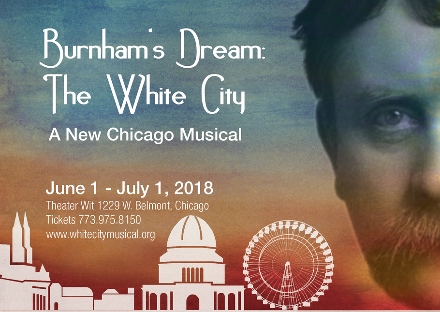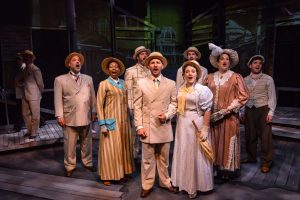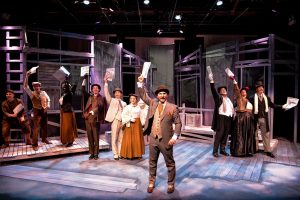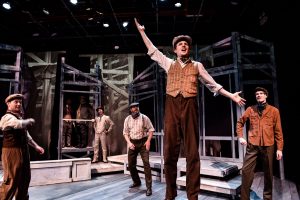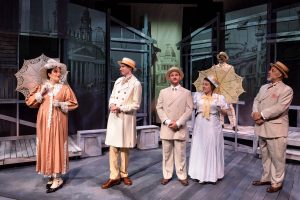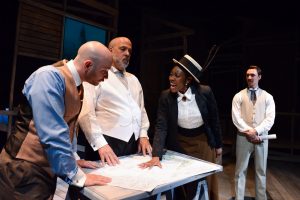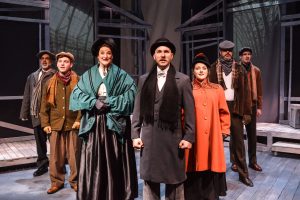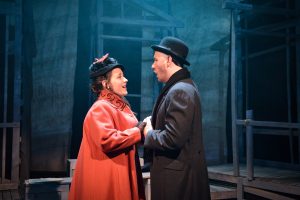OUR LOST DREAM CITY
It’s possible to think that it never happened, that we imagined its splendor to exalt our past. It was the most transient of treasures, with only the Museum of Science and Industry and photos to suggest the Beaux Arts, alabaster magnificence of marvels that bejeweled Jackson Park and the South Side lakefront. What isn’t delusional is that the Chicago World’s Fair of 1892-93 deserves this coming-of-age musical, a labor of love that encompasses the pain of creation as much as old posters suggest the Fair’s pleasures.
A world premiere from Lost and Found Productions, Burnham’s Dream: The White City celebrates the Midwestern pluck of open-eyed dreamers who, despite a terrible fire 22 years before, dared to bring a sterling exposition to the “city on the make.” With it came an immense Ferris Wheel, the first crackerjack, the Japanese Garden on the Wooded Island, Buffalo Bill’s Wild West Show, the Midway Plaisance — all lost souvenirs of a legend still potent after 125 years.
With serviceable, ragtime-infused songs and sometimes labored lyrics by Elizabeth Doyle, a driving script by co-lyricist June Finfer — and Joseph Burke’s projections to illustrate the edifices — this engaging chronicle focuses two years of monumental achievements and the outsized personalities who made the miracle happen.
First in the development of the Fair was a pitched battle full of Windy City bluster to land the bid (“We Gotta Get It!”) and prove that Chicago was more than stockyards, skyscrapers, and railroads. Then came struggles to find the right planners and architects (“We Need a Man”), budget restrictions, acquiring the right materials (“Fair Construction”), achieving proper representation of commerce and society (“It Must Impress”), and catering to or ignoring the many polarized interests that wanted it to be their Columbian Exposition more than another’s (the gorgeous anthem “If We Sing Together”).
It’s inevitable that this “backstage musical” comes down to Daniel Burnham (Pavi Proczko). With invaluable help from his idealistic partner and engineer John Root (Sam Massey), he got to manage the mayhem (“Nightmare”). If Burnham was best at promotion and practicality, the patrician Root imagined a glorious apotheosis of Western civilization (“Celestial City”), however temporarily erected from staff and terra cotta. Root’s sudden death before the Fair could open plunges Burnham into a crisis of confidence and self-accusatory memories (“We Went Sailing”).
Along with intractable deadlines delayed by a typical Chicago winter, labor agitation threatening strikes, accidents (18 died), and the pressure to produce, Burnham had to soothe his alienated wife Margaret (Laura Degrenia) with “I Promise to Cherish You”. He needed to placate her massively moneyed patron Bertha Palmer (Genevieve Thiers), the hotel matron and a booster for the Women’s Building. (She insured that the Fair had one of the first day care centers.) Another cause to contend with: crusading reformer Ida B. Wells (Arielle Leverett), ardently campaigning for the inclusion of minorities (“Sweet Land of Liberty”).
Scruffy Irish foreman Michael O’Malley (Chase Wheaton-Werle) represented immigrant workers clamoring for fair wages. Burnham also had to handle temperamental and snobbish New York architect Richard Hunt (Rob Brady) and semi-corrupt business backers with their own agendas like Lyman Gange (Michael Kingston). (The Ferris Wheel, they gleefully discovered, would make $50,000 a day!) Most of all, “Make No Small Plans” Burnham had to ensure that the whole world would feel welcome at its fair.
And then there was Burnham’s rival and “good angel” Louis Sullivan (Daniel Leahy): A modernist architect who eschews Old World artificiality, he advocates for his prairie-inspired filigrees (“Buildings That Dance”) over Burnham’s retrograde, old-school ornamentation. Along with the electricity that made the Fair even more magical at night, Sullivan’s Transportation Building will predict the 20th century more than the neo-classical homage of the Administration Building and Peristyle.
This glorious civic triumph really was a showplace of the future, as much as it summ(on)ed up the past. The fact that it lasted only half a year makes all the more poignant its achingly fragile and unrecoverable beauty. (You can see it every year now in the Joffrey Ballet’s gorgeous new Nutcracker.) There was great vision behind “Burnham’s Dream,” later manifested in his ambitious 1909 master plan for Chicago’s development, alas never implemented.
Erik Wagner stages this saga with dexterous aplomb, the 10-person cast (perfectly costumed by Alaina Moore) moving efficiently amid Jose Manuel Diaz-Soto’s scaffolding. Music Director Paul W. Thompson sweetly shapes the songs that push the plot. Jessica Texidor supplies the turn-of-the-century choreography.
Burnham’s Dream: The White City works hard to deliver a Valentine to a city that really needs one. Who knows? This blast from the past could give a second wind to the Windy City.
photos by Charles Osgood
Burnham’s Dream: The White City
Theater Wit, 1229 W. Belmont Ave.
Thurs-Sat at 7:30; Sun at 3
ends on July 1, 2018
for tickets, call 773.975.8150 or visit Theater Wit or White City
for more shows, visit Theatre in Chicago
